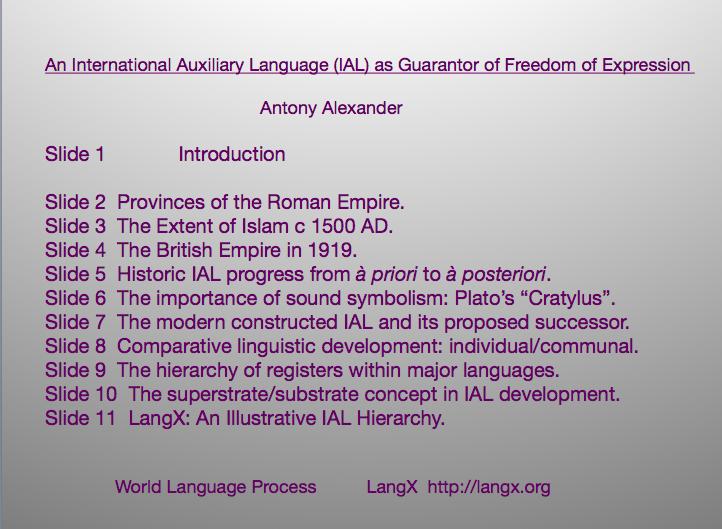 | ||
LangX is a new type of putative global IAL based upon both childhood language development and the historic precedent of completed jargon > pidgin > vernacular progressions. As this subject may be unfamiliar, I will introduce it via the conference theme: “Multilingualism: Challenges and Opportunities”. So let’s start with some well-known challenges to multilingualism. Firstly, nobody would dispute that even expert polyglots can master only a small percentage of the hundreds of existing languages on offer. Then there is the fact that foreign languages often fail to receive priority ahead of non-linguistic subjects on school curricula. Moreover, given the limited number of languages that most people can learn, multilingualism tends to lead to high translation costs; by their very nature its main alternatives, monolingualism and an international auxiliary language, seek to avoid translation, including the expense of multiple translation pairs and the always-present possibility of human and/or mechanical mistranslation. Another more obscure but equally cogent challenge to multilingualism concerns minority languages and might be stated as follows. Multilingualism pre-supposes choice, and where a choice has been available people have tended to opt for the most popular cultures and their languages, so as to maximise commercial and educational possibilities for themselves and their children. Quite often there has been official encouragement in this direction, with minority indigenous languages prohibited within schools and/or other institutions. However, the end result has been the same: people have made choices about their own lives, however easy or difficult that might have been. The 2005 Summer Institute of Linguistics Ethnologue Survey confirmed this trend towards major languages. It found that 347 languages, each with over a million speakers, are spoken by 94% of the world’s population. Moreover, it found that ten of these languages - Chinese, English, Spanish, Russian, French, Portuguese, Arabic, Bengali, Hindi/Urdu and Japanese - are now spoken by about half the world’s population, either as mother tongue or auxiliary language. Clearly, major languages have flourished, and everyone knows that many minority ethnic tongues are threatened or close to extinction.
| ||